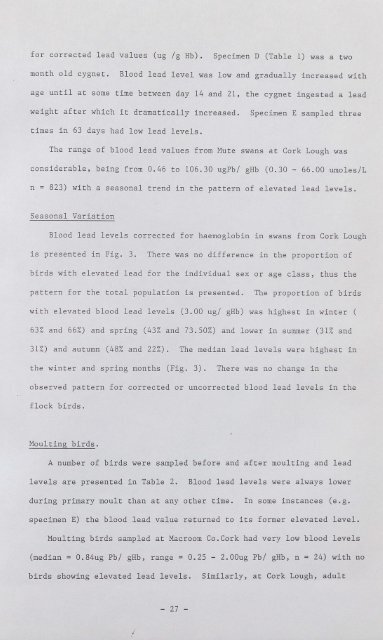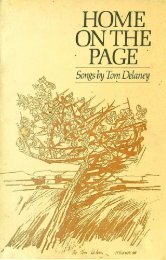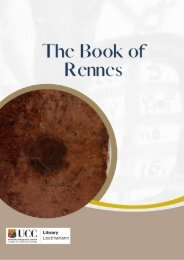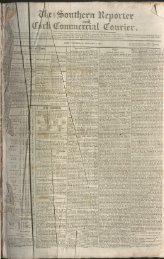Lead Toxicity in Mute Swans
LEAD TOXICITY IN MUTE SWANS Cygnus olor (Gmelin). By JOHN O'HALLORAN A thesis submitted to the National University of Ireland in candidature for the degree of Doctor of Philosophy September 1987
LEAD TOXICITY IN MUTE SWANS
Cygnus olor (Gmelin).
By
JOHN O'HALLORAN
A thesis submitted to the National University of Ireland
in candidature for the degree of Doctor of Philosophy
September 1987
Create successful ePaper yourself
Turn your PDF publications into a flip-book with our unique Google optimized e-Paper software.
for corrected lead values (ug /g Rb).<br />
Specimen D (Table 1) was a two<br />
month old cygnet.<br />
Blood lead level was low and gradually <strong>in</strong>creased with<br />
age until at some time between day 14 and 21, the cygnet <strong>in</strong>gested a lead<br />
weight after which it dramatically <strong>in</strong>creased.<br />
Specimen E sampled three<br />
times <strong>in</strong> 63 days had low lead levels.<br />
The range of blood lead values from <strong>Mute</strong> swans at Cork Lough was<br />
considerable, be<strong>in</strong>g from 0.46 to 106.30 ugPb/ gHb (0.30 -<br />
66.00 umoles/L<br />
n = 823) with a seasonal trend <strong>in</strong> the pattern of elevated lead levels.<br />
Seasonal Variation<br />
Blood lead levels corrected for haemoglob<strong>in</strong> <strong>in</strong> swans from Cork Lough<br />
is presented <strong>in</strong> Fig. 3.<br />
There was no difference <strong>in</strong> the proportion of<br />
birds with elevated lead for the <strong>in</strong>dividual sex or age class, thus the<br />
pattern for the total population is presented.<br />
The proportion of birds<br />
with elevated blood lead levels (3.00 ug/ gHb) was highest <strong>in</strong> w<strong>in</strong>ter (<br />
63% and 66%) and spr<strong>in</strong>g (43% and 73.50%) and lower <strong>in</strong> summer (31% and<br />
31%) and autumn (48% and 22%). The median lead levels were highest <strong>in</strong><br />
the w<strong>in</strong>ter and spr<strong>in</strong>g months (Fig. 3).<br />
There was no change <strong>in</strong> the<br />
observed pattern for corrected or uncorrected blood lead levels <strong>in</strong> the<br />
flock birds.<br />
Moult<strong>in</strong>g birds.<br />
A number of birds were sampled before and after moult<strong>in</strong>g and lead<br />
levels are presented <strong>in</strong> Table 2.<br />
Blood lead levels were always lower<br />
dur<strong>in</strong>g primary moult than at any other time.<br />
In some <strong>in</strong>stances (e.g.<br />
specimen E) the blood lead value returned to its former elevated level.<br />
Moult<strong>in</strong>g birds sampled at Macroom Co.Cork had very low blood levels<br />
(median= b.84ug Pb/ gHb, range = 0.25 -<br />
2.00ug Pb/ gHb, n = 24) with no<br />
birds show<strong>in</strong>g elevated lead levels.<br />
Similarly, at Cork Lough, adult<br />
- 27 -
















